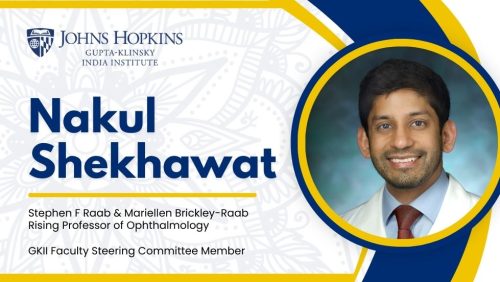
Bridging the Gap Between the U.S. and India: Nakul Shekhawat
Stephen F Raab & Mariellen Brickley-Raab Rising Professor of Ophthalmology GKII Faculty Steering Committee Member
“The best part about my work is the prospect of making things better for everybody. Working together, we can move the needle forward on major public health problems.”
A physician and researcher with expertise in ophthalmology and epidemiology, Dr. Nakul Shekhawat focuses on cataract surgery, corneal transplantation surgery, and research on novel diagnostic technologies. Recently he’s also turned an eye to new treatments for corneal infections which, like cataracts, are a major cause of blindness.
Originally from Rajasthan, India, he vividly recalls coming to the U.S. at seven years old and being struck by the different the scale of things. “I remember getting off the plane and thinking, wow, everything’s big in America: people’s smiles are bigger, everybody is incredibly nice and welcoming, and as a kid I thought it was amazing. That’s really borne out through the years as well.” His childhood interest in scale and size translated into work on improving vision and quality of life.
“One of the best things about ophthalmology is the life-changing surgeries. Cataract surgery confers major benefits to patients, can be performed in 15 minutes, and is one of the most cost-effective procedures in modern medicine,” Dr. Shekhawat said. “What that means is that these procedures can be done at scale. The problems are widespread, affecting millions of people globally, but the solutions can also be scalable and improve the lives of those millions of people. That lends itself very well to public health interventions where, if you rigorously maintain safety and quality of care, you can radically improve lives on a massive scale. The sheer quantity of good you can do for people as an ophthalmologist really appeals to me.”
“The experience of helping a blind person see again never grows old. It continues to bring joy every day.”
His career began with volunteering at a hospital in Rajasthan, where he assisted cataract surgery patients being driven to clinics on incredibly overcrowded buses. Their experience is what motivated him to become an ophthalmologist, and eventually a public health researcher.
“We saw patients being led into the hospital by their arms because they were blind, and then after surgery they walked out on their own—unassisted and independent with a glint in their eye,” he said. “I thought, there’s no greater joy in the world than giving someone the gift of sight and helping them gain their dignity back.”
After he completed a decade of medical and surgical training in the U.S., Dr. Shekhawat’s first patient as an independent surgeon was a woman experiencing homelessness related to blindness from advanced cataracts. She lacked social support, was unable to work, could not read her mail to pay her bills, and had been evicted from her home.
“Of all the people who could have been my first surgical patient, of course it had to be a person with the same type of blinding cataract that I was inspired to help cure abroad – except this was in America,” he said. “She could see within minutes after the operation. She started crying in the postoperative recovery area because she hadn’t seen in years. The nurses were crying, and I teared up as well.”
“When I saw her in clinic a few weeks later she walked quickly and confidently down the hallway by herself, which is something she was not able to do previously because she had been blind and unable to navigate. That memory will always stay with me.”
The U.S. and India Dynamic
One thing Dr. Shekhawat wants people to understand is the global relevance of work being done in India, including for populations in the U.S. He notes there are common themes when it comes to challenges in healthcare delivery, regardless of country. The care patients receive is highly dependent on where they live, their education, their income, and their demographics.
“Where the patient is from unfortunately does determine how late they come in to see a doctor for their condition, and what their chances of recovery are. That’s been a longstanding issue in India and is increasingly recognized as a major problem in America as well. Solutions we come up with to address those challenges in either country are globally applicable,” he said.
One’s of Dr. Shekhawat’s major efforts is a smartphone-based telemedicine platform that has applications for both India and the US. With Drs. Rama Chellappa and Kunal Parikh from the GKII Steering Committee, Dr. Shekhawat has been working since the beginning of the COVID-19 pandemic on using smartphone cameras and artificial intelligence to screen for common blinding diseases, such as cataracts, without requiring rural patients living in geographically isolated areas to travel several hours to an urban eye hospital to see an ophthalmologist. His team’s work has been conducted at both the Aravind Eye Hospital in India and at Johns Hopkins Medicine.
Part of this research and AI training means collecting data at eye hospitals, using high-powered computers at the Whiting School of Engineering in Dr. Chellappa’s lab to train AI algorithms, and then deploying them in a safe and controlled manner.
“We rigorously evaluate how well the algorithm performs in the field. We ask in what clinical settings is it appropriate to use, and when it might be safe to rely on an AI algorithm instead of real human to interpret the information that’s coming in. Defining the real-world use case is the key,” he said.
“Working with our collaborators at Johns Hopkins and in India, we can help reimagine healthcare delivery,” Dr. Shekhawat said. “Expanding access to eye care enables massive contributions to the well-being of humanity. That, I think, is the most exciting part.”